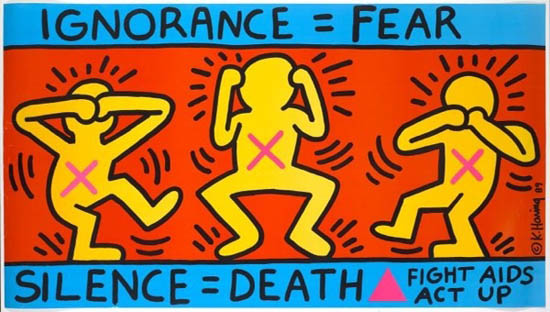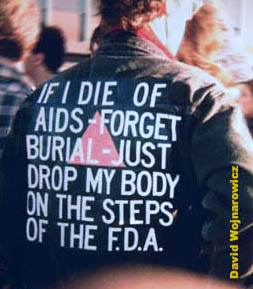A Never Ending Crisis: HIV/AIDS

A poster for Act Up by Keith Haring made in ’87. Haring died in 1990 of AIDS-related complications.
On December 6, the World Affairs Breakfast Club sat down to talk about the HIV/AIDS crisis and HIV/AIDS awareness in honor of Worlds AIDS day which happened on December 1. Although many believe that the HIV/AIDs crisis is over, it is still an issue with persistent stigmatization, lack of education, and
discrimination in the US and abroad. In order to combat this health teacher Ms. Robbins and US History teacher Mr. Stein gave a background on the realities and history of HIV/AIDS.
Ms. Robbins first started out by distinguishing the difference between HIV (Human Immunodeficiency Virus) and AIDS (Acquired Immunodeficiency Syndrome). HIV is a virus that can be contracted and develop into AIDS if not treated. HIV can be transmitted through bodily fluids like blood, breastmilk, semen, and vaginal secretions. Some of the most common ways HIV is transmitted is through sharing needles (HIV is now on the rise due to the Opioid Crisis), having unprotected oral, vaginal, and anal sex, breastfeeding, and birth. However, there has been a decrease in babies born with HIV because if a mother finds out she is HIV+ when pregnant she can go on medication to help prevent the baby from acquiring the virus and then get a caesarean section (so that the baby is not further exposed to the virus via blood). Ms. Robbins explained how getting HIV via a blood transfusion used to be a major issue, but has not been one since 1985 when blood treatment centers started to test for blood. She also dispelled the myths that HIV can be transmitted via saliva.
Mr. Stein started out his brief history lesson by an update on HIV AIDS. If you are undetectable for HIV, you are untransmittable according to heavy research which has been approved by the U=U campaign. This campaign aims to “influence public opinion, causing more people with HIV (and their friends and families) to comprehend that they can live long, healthy lives, have children, and never have to worry about passing on their infection to others.” (Prevention Access Campaign). This is major considering the large stigmas that surround HIV+ people and the discrimination that they face even today. In an interview with CBS, Roscoe (no last name), expressed how he was made to feel, “shameful and undeserving of love” because of his HIV status. Mr. Stein explained how the majority of the stigma around HIV comes from a lack of knowledge about HIV-AIDS and how the epidemic will only end when education continues.
The history of HIV AIDS is relatively recent, but it an incredibly important one. The first reported case of HIV in the United States was in 1981, but the first known case was in the Congo in 1959. There became an immediate association with groups and HIV and stigmatization followed homosexuals (mostly men–83% of HIV+ people were gay men), heroin users, hemophiliacs, and Haitians. The government did little to help solve research because these people were already seen as contributing to problems in the US by refusing to conform. ACT UP was the first major organization and is responsible for drugs and treatment.

The government still targets many HIV+ people by making medication incredibly expensive under certain insurances. The HIV/AIDS crisis is currently resurging due to needle sharing because of the opioid crisis.
It is important to remember that this crisis is not over and to continue to fight against stigma and for humanity.









